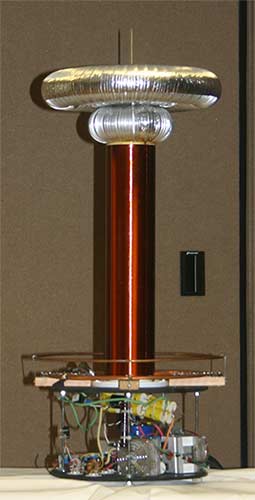Science is teh AWESOME!
The Geek Group, an organization founded by physicsduck, brought a pair of singing Tesla coils to Dragon. Tesla coils are cool–they’re scary high-voltage devices that make noise and shoot lightning bolts. Singing Tesla coils, which shoot lightning bolts and make music, are even cooler.


Tesla coils buzz when they operate. Essentially, what you do is you inject a current into the primary winding, which is a loop of wire at the base of the tall, skinny coil. This indices a current in the secondary winding, which is the tall, skinny coil. The current travels up the coil ’til it hits the top, then travels back down again. You inject another current into the primary winding, and it creates another, stronger wave of induced current in the secondary winding, which travels up the coil and then back down again, when you hit it again, and each time it gets stronger until finally it becomes strong enough to shoot lightning bolts out the top. (That’s the Reader’s Digest condensed version for non-geeks, anyway).
I’m assuming that making them sing involves changing the frequency of the voltage supplied to the primary winding, so that they buzz at a different rate. If that’s true, it suggests that there’s a limit to the range of tones you can squeeze out of the coil, because every Tesla coil has an optimum frequency (determined by the size and construction of the coil) for the primary voltage. Deviate from that frequency and the coil operates less efficiently; stray too far from it, and the coil doesn’t work at all.
In any event, these things are cool as hell to watch. Even if there does need to be more VNV Nation on the playlist.

yay! purple flames 🙂
wicked cool 🙂
yay! purple flames 🙂
wicked cool 🙂
ok all this DragonCon stuff people are talking about makes me wish I could have gone!
ok all this DragonCon stuff people are talking about makes me wish I could have gone!
Cool. Anybody shrinking quarters?
http://205.243.100.155/frames/shrinker.html
~r
Cool. Anybody shrinking quarters?
http://205.243.100.155/frames/shrinker.html
~r
. . . why, look, a Violet Wand on steroids!. . .
. . . why, look, a Violet Wand on steroids!. . .
I wish I’d seen those 🙁
I wish I’d seen those 🙁
Couldn’t you change the resonant frequency by switching in and out portions of the primary coil, thereby changing its inductance? I’m thinking along the lines of multiple taps.
Of course, to get a full octave, I guess that’d require switching out as much as half of the coil. I guess you could get a wider dynamic range if you also switched the caps around as well.
Aha! It’s not that way at all. This page describes one way to do it.
Couldn’t you change the resonant frequency by switching in and out portions of the primary coil, thereby changing its inductance? I’m thinking along the lines of multiple taps.
Of course, to get a full octave, I guess that’d require switching out as much as half of the coil. I guess you could get a wider dynamic range if you also switched the caps around as well.
Aha! It’s not that way at all. This page describes one way to do it.